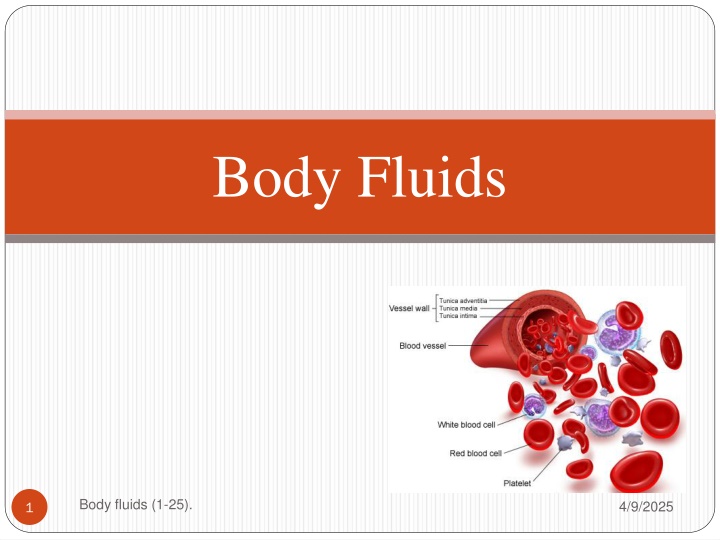
Body Fluids and Electrolytes Composition
Explore the world of body fluids, including their origin, distribution, composition, and the role of electrolytes within. Learn how water comprises a significant percentage of the human body, along with the various fluid compartments and their functions. Delve into the essential electrolytes present in body fluids, their functions, and the importance of maintaining electrolyte balance for overall health.
Download Presentation

Please find below an Image/Link to download the presentation.
The content on the website is provided AS IS for your information and personal use only. It may not be sold, licensed, or shared on other websites without obtaining consent from the author. If you encounter any issues during the download, it is possible that the publisher has removed the file from their server.
You are allowed to download the files provided on this website for personal or commercial use, subject to the condition that they are used lawfully. All files are the property of their respective owners.
The content on the website is provided AS IS for your information and personal use only. It may not be sold, licensed, or shared on other websites without obtaining consent from the author.
E N D
Presentation Transcript
Body Fluids Body fluids (1-25). 4/9/2025 1
Body Fluids Body fluids are liquids originating from inside the bodies of living people. Water makes up approximately 60% of the human body weight (~ 42 L). Body fluids (1-25). 4/9/2025 2
Body Water Fluid compartments Intracellular fluid Extracellular fluid Interstitial fluid Blood plasma Lymph transcellular fluid Body fluids (1-25). 4/9/2025 3
Total Body Water Body fluids (1-25). 4/9/2025 4
Distribution of body fluids Body fluids (1-25). 4/9/2025 5
Distribution of body fluids ECF include: Interstitial fluid - the fluid between cells in tissues. Plasma - the fluid component of blood Lymph - the fluid in our lymphatic vessels Transcellular fluids. Body fluids (1-25). 4/9/2025 6
Distribution of body fluids(cont.) Transcellular fluids: Cerebrospinal Fluid (CSF) - the fluid within the CNS Synovial fluid - the fluid within most joints Peritoneal, pericardial, pleural, pancreatic, intraocular, biliary fluids Fluid compartments are separated by membranes that are freely permeable to water. Body fluids (1-25). 4/9/2025 7
Composition of body fluids Sodium Potassium Calcium Magnesium Chloride Phosphate Sulphate Glucose Amino acids Fatty acids Hormones Enzymes Organic substances Inorganic substances Body fluids (1-25). 4/9/2025 8
Electrolytes in body fluids Ions form when electrolytes dissolve and dissociate. 4 General functions: Control osmosis of water between body fluid compartments. (Loss of sodium, at least initially, leads to loss of water and contraction in the extracellular fluid volume). Help to maintain the acid-base balance Carry electrical current Serve as cofactors Body fluids (1-25). 4/9/2025 9
Differences between ECF & ICF ECF ICF Cations: Na+(142mmol/L) K+(4.2) Mg2+(0.8) Anions: Cl-(108) HCO3-(24) Cations: Na+ (14) K+(140) Mg2+(20) Anions: Cl-(4) HCO3-(10) Phosphate ions Nutrients: High proteins. Nutrients: O2, glucose, fatty acids, & amino acids. concentrations of Wastes: CO2, Urea, uric acid, excess water, & ions. Body fluids (1-25). 4/9/2025 10
Functions of ICF & ECF ICF: is vital to normal cell function, it contain solutes such as oxygen, electrolytes and glucose. It provides a medium for metabolic processes. (pH = 7). ECF: it is the transport system that carries nutrients and waste products from the cell. (pH = 7.4) Body fluids (1-25). 4/9/2025 11
Significance of body fluids In Metabolic reactions: water inside the cells forms the medium for various metabolic reactions, which are necessary for growth and functional activities of the cells. In Transport mechanism: Body water forms the transport medium by which nutrients and other essential substances enter the cells and wastes come out of the cells. Body fluids (1-25). 4/9/2025 12
Significance of body fluids (Cont.) In Temperature regulation : body water plays a vital role in the maintenance of normal body temperature. In texture of tissues : water inside the cells is necessary for the characteristic form and texture of various tissues. Body fluids (1-25). 4/9/2025 13
Significance of body fluids (Cont.) In Homeostasis: Body cells survive in the fluid medium called internal environment or milieu interior. Growth and functions of cells: Glucose, amino acids, lipids, vitamins, ions, oxygen etc., in proper quantities in the internal environment. Body fluids (1-25). 4/9/2025 14
Examples of Body Fluids Ocular Fluid (aqueous humour): is a clear, gelatinous fluid similar to plasma, made up mostly of water (99%), hyaluronic acid, sugar, ascorbic acid and inorganic salts. Bile secreted from the liver into the duodenum to aid in lipid digestion. It is composed of water (85%), bile salts (10%), mucus and pigments (3%), fats (1%). Body fluids (1-25). 4/9/2025 15
Examples of Body Fluids (Cont.) Gastric Juice: Is a fluid formed in the stomach, used to digest proteins. It is composed of hydrochloric acid (0.5%) and large quantities of potassium and sodium chloride. Saliva: Is produced by salivary glands in the human mouth. Saliva is composed of water (98%) and the remaining 2% is mucus, electrolytes, enzymes and various antibacterial compounds. Body fluids (1-25). 4/9/2025 16
Examples of Body Fluids (Cont.) Semen: Also known as seminal fluid, is the fluid secreted from the male sexual glands. Sweat: Is the production of fluid by the sweat glands in the skin. It is made up of mainly water and various dissolved solids. Body fluids (1-25). 4/9/2025 17
Factors affecting body fluids Water intake & output. Age: % of total body weight. Infants (80%), late teen andAdults (60%), old age (40-50%) Sex: Adult males: 60% Adult females: 40-50% Body fluids (1-25). 4/9/2025 18
Factors affecting body fluids (Cont.) Obesity (adipose tissue): The greater the proportion of adipose tissue, the less the % of water. Climate. Habits. Level of physical activity. Body fluids (1-25). 4/9/2025 19
Body fluids (1-25). 4/9/2025 20
Daily intake & output of water Body fluids (1-25). 4/9/2025 21
Water may serve as: Medium of metabolic reactions within cells. Transporter of nutrients, waste products, and other substances. A lubricant. Shock absorber. Regulates and maintains body temperature. Body fluids (1-25). 4/9/2025 22
Disorders of Water Balance Body fluids (1-25). 4/9/2025 23
Dehydration Loss of water from the body, e.g., vomiting, diarrhea, sweating, & polyuria. Leads to in both ECF & ICF volumes. Osmolarity in both ECF & ICF. Body fluids (1-25). 4/9/2025 24
Dehydration(cont.) General signs: - Dry tongue. - loss of skin elasticity. - soft eyeballs (due to lowering of intraocular tension). - blood pressure (if 4-6L loss). - Hb, & Hct (packed cell volume). Treated with fluid replacement (orally, or IV). Body fluids (1-25). 4/9/2025 25











